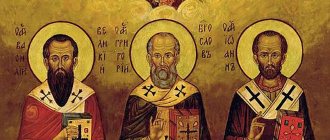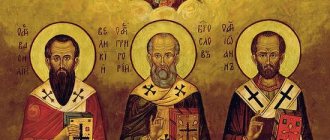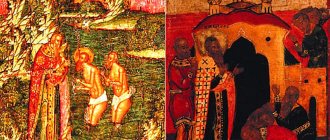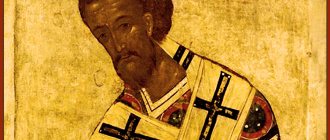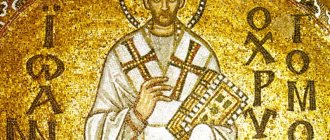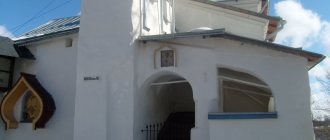The memory of our three holy fathers: Basil the Great, Gregory the Theologian and John Chrysostom takes place on February 12 (January 30, old style). The three great saints are revered as universal teachers who left us a great theological heritage.
Veneration of three saints: Basil the Great, Gregory the Theologian and John Chrysostom
The history of establishing the memory of the three Ecumenical Hierarchs dates back to the reign of the Byzantine Emperor Alexios I Komnenos (1056/1057 - 1118), when there were disputes in Constantinople about the primacy of any of these Church Fathers. According to church tradition, in 1084, three saints appeared together to Metropolitan John of Euchaitis (c. 1000 - c. 1070) and ordered to establish a common day to celebrate their memory, declaring that they were equal before God.
On January 30, 1084 (Old Art.), a separate celebration was established dedicated to three ecumenical teachers: Basil the Great, Gregory the Theologian and John Chrysostom. From the first half of the 12th century, the service of three saints was recorded in Greek liturgical books. The earliest example is the Charter of the Constantinople Monastery of Pantocrator (1136), which contains the rules for the consecration of the temple on the feast of “Saints Basil, the Theologian and Chrysostomos.” Conversation of the Three Hierarchs was distributed in the form of a question and answer, written on behalf of Basil the Great, Gregory the Theologian and John Chrysostom. The oldest Russian lists of Beseda date back to the 15th century; the South Slavic parchment list of the 14th century is known. “The Conversation” was included in the indexes of false books immediately after its appearance. The earliest index in which it is mentioned dates back to the 30-40s of the 15th century (“What was said about Basil of Caesarea, and about Gregory the Theologian, and about John Chrysostom, that you ask and answer about everything in a row is false,” State Historical Museum, Chudovskoye Collection, No. 269); this index is associated with Metropolitans Cyprian (1390-1406) and Zosima (1490-1494). It is believed that the basis was compiled by Cyprian, and Zosimas only supplemented the list, but the exact volume of additions is not known, since Cyprian’s index has not been preserved. However, it is known that it existed, since Zosima’s list states: “And this is written from the prayer book of Metropolitan Cyprian of All Rus'.”
Great lamps
In the hymns of the service to the Three Saints, the Church calls them the “earthly trinity,” different and dissimilar individuals, but united by God’s grace.
In their works and their lives, they commanded us to honor and glorify the Most Holy Trinity - the One God in three Persons, to preserve the strength of faith and the unity of the Church. “Great luminous lamps, indestructible pillars of the Church, let us praise those who enjoy the good and the words of those, abundantly and grace: the wise Golden-speaking and the Great Basil with Gregory the bright Theologian. Let us cry out to them, calling from our hearts: most great saints, pray to Christ the God of sins to grant your holy memory to those who celebrate love” (sedalen, tone 8).
Author: Irina Nechaeva
Three ecumenical saints Basil the Great, Gregory the Theologian and John Chrysostom. Icons
Iconographic images of the three saints Basil the Great, Gregory the Theologian and John Chrysostom have been known since the 11th-12th centuries. The icon of the three saints is mentioned in the Charter of the Monastery of the Mother of God of Kekharitomeni, founded by Empress Irene Duqueney in the 12th century in Constantinople. The first surviving image of the three saints is in the Psalter, made by Theodore, a scribe of the Studian monastery in Constantinople, in 1066 (now in the British Museum). Images of the three saints have been found in the holy order in the altar apse since the time of the Byzantine emperor Constantine Monomakh (1042-1055) in the Church of Sophia of Ohrid, in the Palatine Chapel in Palermo.
Icon of the Ecumenical Teachers. Byzantium, XIV century. Byzantine Museum, Athens
In Ancient Rus', iconographic images of the three saints have been known since the end of the 14th century. The first images are the Pskov icon of the Three Saints with Saint Paraskeva (15th century). The saints are depicted full-length with a scroll or book in their left hand, and their right hand in a blessing gesture.
Ecumenical teachers Basil the Great, Gregory the Theologian and John Chrysostom. Pill icon. Novgorod. End of the 15th century From St. Sophia Cathedral. Novgorod Museum
Ecumenical teachers Basil the Great, Gregory the Theologian and John Chrysostom. Icon, 17th century
Icon of the Ecumenical teachers Basil the Great, Gregory the Theologian and John Chrysostom. Pskov, mid-16th century. Moscow, State Historical Museum
Saints Gregory the Theologian, Basil the Great, John Chrysostom. XIX century Nevyansk
Basil the Great
Holy son of saints
The Church began celebrating his memory immediately after his death. Saint Amphilochius of Iconium, in a sermon on the day of the saint’s death, said: “It was not without reason and not by chance that the divine Basil was separated from his body and reposed from earth to God on the day of the Circumcision of Jesus, celebrated between the day of the Nativity and the Baptism of Christ. Therefore, this blessed one, preaching and praising the Nativity and Baptism of Christ, extolled spiritual circumcision, and he himself, having stripped off his body, was worthy to ascend to Christ precisely on the sacred day of remembrance of the Circumcision of Christ. That is why it has been established on this day to annually honor the memory of the Great One with celebration and celebration.”
The future Archbishop of Caesarea of Cappadocia, Basil, was born around 330 into a noble and wealthy family. His grandfather and grandmother hid in the forests for seven years during Diocletian's persecution. His mother was the daughter of a martyr, and his father was a famous lawyer and teacher of rhetoric. There were ten children in the family, and five of them were later ranked among the clique of saints.
Vasily grew up on his parents' estate, was raised by his mother and grandmother, received his initial education under the guidance of his father, then studied with the best teachers in Caesarea, then in Constantinople and, finally, in Athens. Philosopher, philologist, orator, lawyer, natural scientist, who had deep knowledge of astronomy, mathematics and medicine - in the words of Saint Amphilochius, “it was a ship as loaded with learning as it was roomy for human nature.”
In Athens he became friends with Gregory the Theologian. Later, in a speech of praise to Basil the Great, Saint Gregory spoke enthusiastically about this time: “We were guided by equal hopes in the most enviable matter - in teaching... We knew two roads: one - to our sacred temples and to the teachers there; the other - to the teachers of external sciences."
Saint Basil the Great. V. Shebuev
Returning to Caesarea, Vasily first taught rhetoric, then was baptized, was made a reader, then, “wishing to gain a guide to the knowledge of the truth,” he went to Egypt, Syria and Palestine, to the great Christian ascetics. He decided to imitate them: he distributed property to the poor, settled in a family estate on the river bank, gathered monks around him, summoned his friend Gregory the Theologian with letters, and they labored in strict abstinence in a dwelling without a roof, without a hearth, eating the merest food. They themselves cut stones, planted and watered trees, carried heavy loads and read more and more deeply into the Holy Scriptures.
Heresy of Arius as an impulse to action
But during the reign of Emperor Constantius, Basil was called to ministry: he returned to Caesarea and was ordained first as a deacon, then as a presbyter. But Bishop Eusebius was jealous of his popularity, and Basil returned to the desert and began building monasteries. And he came to Caesarea again only after the accession of Emperor Valens, an adherent of the Arius heresy, when difficult times came for Orthodoxy and “a great struggle lay ahead.”
From that time on, church rule passed to Vasily, although he occupied only second place in the hierarchy. He preached sermons every day, often twice - in the morning and in the evening. He compiled the order of the liturgy, wrote interpretations on the Sixth Day, on the 16 chapters of the prophet Isaiah, on the psalms, compiled a collection of monastic rules, and when Bishop Eusebius of Caesarea died in 370, he took his place.
But illness, labor, abstinence, worries and sorrows exhausted his strength early: Saint Basil reposed on January 1, 379 and was soon canonized. He was only 49 years old.
Temples in Rus' in honor of three saints Basil the Great, Gregory the Theologian and John Chrysostom
In honor of the three saints Basil the Great, Gregory the Theologian and John Chrysostom, a temple was consecrated in the Spaso-Eleazarovsky Monastery (Pskov region). The monastery was founded in 1425 by the Monk Euphrosynus of Pskov (in the world Eleazar; 1386-1481).
Spaso-Eleazar Monastery
A temple in Kulishki in Moscow was consecrated in honor of the three ecumenical saints. In the 15th century, Vasily I built his summer palace here with a house church in the name of the Holy Equal-to-the-Apostles Prince Vladimir. The princely gardens were laid out nearby, and stables were located next to them. A wooden church was built in the horse yard in the name of the holy martyrs Florus and Laurus. A house metropolitan church in the name of the Three Ecumenical Hierarchs was built next door. In the 16th century, the grand ducal estate was moved to the village of Rubtsovo-Pokrovskoye due to the fact that the southeastern part of the White City began to be actively populated. Churches that were previously located in residences became parish churches, and churchyards were formed at them. In 1674, a stone church of the Three Hierarchs was built.
Church of the Three Saints on Kulishki in Moscow. Modern look
In honor of the three saints Basil the Great, Gregory the Theologian and John Chrysostom, the chapel of the Transfiguration Cathedral of the Spaso-Kamenny Transfiguration Monastery on Fr. Stone in the Vologda region. For more than two hundred years, the buildings on the island were only wooden. After a big fire that destroyed all the monastery buildings, in 1478 they began construction of the first stone church in the entire Russian North - the Transfiguration Cathedral, which was consecrated in 1481. In its original form, the Transfiguration Cathedral was a four-pillar, three-apse cross-domed church on a low basement. At the end there were three tiers of kokoshniks and two chapters: a large one in the center and a small one above the south-eastern corner, where the chapel was located. The abundant decoration covering the walls, apses and dome drums consisted of ceramic relief tiles, curbs, runners and niches. In 1925, in the monastery premises they tried to set up a colony for juvenile delinquents, who fled in the fall. In addition, the autumn fire damaged many buildings. In 1937, the Transfiguration Cathedral was also blown up for the sake of bricks that they wanted to use for the construction of the local House of Culture. The resulting brick could not be used for construction.
Spaso-Kamenny Monastery in 1909
In honor of three saints, Basil the Great, Gregory the Theologian and John Chrysostom, the chapel of the Church of the Epiphany from Zapskovia (Pskov) was consecrated. The temple was first mentioned in 1397; The current temple was erected in 1495 on the site of an earlier one, as the main temple of the Epiphany end in Zapskovye. The interior of the church is four-pillar, cross-domed, with raised arches. The northern aisle had a pillarless ceiling structure. The facades of the temple are divided by blades, ending with bladed arches, the apses and the drum are decorated with traditional, beautifully laid out rows of the “Pskov necklace”: “curb - runner - curb”.
Church of the Epiphany from Zapskovye
There is no information about Old Believer churches in the name of three saints Basil the Great, Gregory the Theologian and John Chrysostom.
Brief biography
St. Basil the Great
Iconography: Basil the Great, saint Dates: XVI century. Third quarter of the 16th century. Icon painting school or art center: Tver. Origin: From the church of the village of Georgievskoye, Bezhetsky district, Kalinin region. Material: Wood, gesso, tempera. Dimensions of the icon: height 100 cm, width 32 cm Life-size image of Basil the Great. With both hands he supports an unfolded scroll with text. The saint is wearing a white cross veil and a white omophorion and cassock. KP 0257. © Central Museum of Ancient Russian Culture and Art named after Andrei Rublev
Basil the Great was a scientist, monk, and manager; he lived a very short life from 330 to 379. By our standards, he died still quite a young man, since he did not live to be 50 years old, but at the same time he left a memory of himself for centuries, giving the Church treasures of his works, instructions, rules, conversations, interpretations, and with his very moral life he showed an example of active service people and God.
The high significance of the saint’s activities cannot be overestimated, especially considering the state of the Church at that time. The church was just beginning to be built then, freed from persecution. Communities existed separately, there was no uniformity of service, dogmas were just being formulated, and the pagan environment still dominated. At the same time, diseases of error and heresy have already appeared in the church environment.
Basil the Great paved a bridge for the human mind to move from ancient consciousness and the philosophical search for truth to the Christian worldview, Christian morality and Christian foundations of social life, establishing faith and piety around. He contributed to the development of Orthodox dogma, to the definition of the concepts of “essence” and “hypostasis,” which served as a basis for the fight against Arianism and became the basis for the formulation of the dogma of the Holy Trinity.
The exegetical Conversations of the saint on the Sixth Day are widely known, providing the theological basis for the development of the natural sciences. In addition to literary activity and theology, Vasily did a lot for the organization of the Church organization, streamlining its internal structure, and also worked to formalize the service, drawing up the rite of the Divine Liturgy. The people remembered the saint for his charitable and patronage activities.
Basil the Great did a lot for the Church; it is necessary to separately note which family this man came from, then the strength of his faith and the source of his active energy will become clear. Of particular importance in modern conditions of the weakening of traditional values is the need to unite and strengthen the Christian family, and the life of Basil the Great shows church people the power of the family root, the power of prayers for loved ones and their loved ones.
The family is a support for the human soul, a breeding ground for the cultivation of faith, a gift-bearer for passing on from generation to generation the good experience of life in Christ. Such a family were those close to Basil the Great, who taught him holiness. The saint's paternal grandmother, Macrina (the eldest), was canonized by the Church (May 30 / June 12). She was a pupil of St. Gregory the Wonderworker of Neocaesarea (†c. 270), who is considered the author of the most successful exposition of the Creed, which he introduced into the Neocaesarea community in early times.
Interesting fact
Macrina, who learned the dogmas of faith from Gregory, passed them on to her grandson Vasily, instructing him from an early age in the love of God and “pious teachings,” and most importantly, she taught him to always thank the Lord for everything.
Saint Basil's mother Saint Emilia (January 1 / January 14) was from Caesarea and became an orphan early; her parents were martyrs for the faith under the Emperor Licinius. Although the beautiful Emilia wanted to devote herself to God, in order not to fall a victim of violence, the orphan married an educated and kind young lawyer Vasily (senior), the son of the pious Macrina.
Holy family of St. Basil the Great. Icon 1999
Interesting fact
The parents of the future saint, Basil and Emilia, had ten children, five of whom became saints: Basil the Great, Bishop of Caesarea of Cappadocia; Gregory, Bishop of Nyssa (January 10/January 23); Peter, Bishop of Sebaste (January 9/January 22); Venerable Macrina the Younger (July 19/August 1) and Blessed Theosevia, otherwise Theozva the Deaconess (January 10/January 23).
This is the good fruit brought by the Christian marriage of Vasily and Emilia and the good upbringing in the family through the pious life of the parents and the religious instructions of the grandmother-confessor, who suffered a lot in life for the faith of Christ, but never grumbled, but firmly believed in the providence of God and did not forget for everything Thank him.
The family cared about the upbringing and education of children. So Basil, having received sufficient education at home from his father, a highly educated lawyer and teacher of rhetoric, was sent to Caesarea Cappadocia to the best school, and then to the center of classical education - in Athens. While still at the Caesarea school, Vasily became friends with a fellow student, Gregory. Vasily and Grigory retained this student friendship for the rest of their lives, becoming close to each other like brothers. In the future, Gregory will also become a saint, and the Church will call him the Theologian.
After completing his secular studies, Vasily went not to the capital, but to the Egyptian desert to the hermit monks to learn Divine wisdom from them. He's writing:
“I was amazed at their moderation in food, their endurance in work, I was amazed at their deep prayerful mood, I was amazed at how they successfully fight sleep, how their thoughts are always sublime and free, despite hunger and thirst, the cold and scanty clothing... Living as if their body did not belong to them, they actually showed what it means to live in this world with the thought of another world and to have your own fatherland in heaven... I prayed that I too, as far as my strength would allow, could become an imitator of these people "
But soon Vasily had to leave the desert to actively defend Orthodoxy from the Arian heresy. Already in the rank of Bishop of Caesarea, he fearlessly fought against the heresiarchs, who possessed both ecclesiastical and secular power. The saint did not lose courage even before the Arian Emperor Valens, even under the threat of death he stood in the faith of Christ, thus responding to the insane force:
“If you take away my property, you will not enrich yourself, and you will not make me a beggar. I believe that you do not need these old clothes of mine and several books in which all my wealth lies. There is no exile for me, because I am not bound by place and the place where I live now is not mine, and wherever they send me will be mine... And what can torment do to me? - I am so weak that only the first blow will be sensitive to me. Death for me is a blessing: it will sooner lead me to God, for whom I live and work, and to whom I have long been striving... In everything else we are meek, more humble than anyone, and not only before such power, but before everyone, because This is what the law has prescribed for us. But when the matter is about God and they dare to rebel against Him, then we, blaming everything else for nothing, look only at Him alone, then fire, sword, beasts and iron tormenting the body will rather be a pleasure for us than frighten us.”
Power retreated before Truth. Vasily devoted his entire life to serving the Church of Christ, strengthening, protecting, enlightening and improving it. In all the sorrowful circumstances of his life, he thanked the Lord for everything.
This is what Basil the Great, the great shepherd who taught people to get rid of the sin of ingratitude, said:
“Nowadays many fall into the vice of evil people, not respecting what they have and wanting what they don’t have. For, not thinking about those who are lower than them, they do not express gratitude to the Benefactor for what they have, but on the contrary, when compared with what and who is higher than them, they calculate what they lack and, not having what belongs to others, they grieve and they grumble as if they have lost their property. The slave is indignant that he is not free; brought up in freedom - which is not of high origin; a nobleman complains that he is not too rich; the rich man grieves and laments that he is not the ruler of cities and nations; a military leader who does not reign; a king who does not possess all the sunflowers, but that there are still nations who have not bowed under his scepter. What emerges from all this is that the Benefactor receives no gratitude for anything.”
1
January
379
Saint Basil died in the ninth year of his episcopal ministry, having had time to deliver his farewell speech and ordain several close disciples.
His last words were: “In Your hands I commend my spirit” (Ps. 30:6). He was buried in the city of Caesarea Cappadocia (modern Kayseri, Turkey), and later the relics were taken to the west. Some of the relics and the venerable head of the saint are preserved on Mount Athos.
St. Gregory the Theologian
Icon of St. Gregory the Theologian and the Exaltation of the Cross
Gregory the Theologian, like his friend Vasily, came from a wealthy wealthy family; he was born around 330 near the city of Nazianza in Cappadocia. In this city his father, also Gregory, was a bishop and known as Saint Gregory of Nazianzen the Elder (January 1/January 14). Gregory loved his father and described him this way:
“He is meek, not angry, calm in appearance, ardent in spirit, rich in visible gifts, and even more so in hidden gifts.”
But even more, the saint loved his mother, Nonna, who was also glorified as a saint (August 5/August 18). Saint Nonna showed the church people an example of active Christian love. From the first day of family life, she became for her husband, who came from a pagan family, a lamp of faith, convincing him to accept Holy Baptism.
Gregory the Theologian in his writings wrote about the family life of his parents:
“The wife God gave to my parent was not only a collaborator for him, which is not very surprising, but also a leader. She herself, in word and deed, directed him to everything excellent. Day and night she fell before God, in fasting and with many tears she asked Him to grant salvation to her head and worked tirelessly on her husband, trying to win him in various ways.”
At the age of 45, Gregory the Elder, convinced by the light of Christian love emanating from his wife all his life, was baptized, then became a presbyter and finally took the episcopal see of the city of Nazianza. Nonna has always been a support for her husband in his chosen difficult path of serving the Church of Christ. Saint Nonna, in her marriage to Gregory the Elder, had three children: sons Gregory and Caesarius, and the eldest daughter Gorgonia, who was also glorified by the holy Church (February 23/March 8).
Saint Gorgonia, following the example of her mother, brought her husband to Christ. Gregory the Theologian highly valued the feat of a Christian sister, mother of a family, mentor in the faith of everyone around her, not with tedious edifications, but with true love, deeds of faith and piety:
“She devoted herself entirely to God. But what is especially good and worthy of respect in her is that she won over her husband to her side and had in him not an obstinate master - a good co-servant. Not only that: she made the very fruit of the body, that is, her children and grandchildren, the fruit of the spirit, for she purified the entire clan and the entire family, like a single soul, and purchased it for God... Throughout her life, she served as an example for children of all that is good, and when she was recalled from here “She left behind her will to her family as a silent instruction.”
Gregory himself received his first instructions in the faith from his mother Nonna; when he came of age, he was well educated and studied with the best philosophers and rhetoricians in Athens. During his student years, he acquired a lifelong friend, Vasily, with whom, after graduation, they retired from the secular bustle to a monastic cell, preferring asceticism, godly thinking and following Christ along the way of the cross to a brilliant career and entertainment of golden youth.
All his life Gregory loved solitude and prayer; his poetic soul was reluctant to tear itself away from the contemplation of Divine silence. But he always neglected his own interests for the sake of the common church cause, taking his mind away from prayer, Gregory went out to preach. At the insistence of his friend Vasily, he was forced to take the episcopal see in Sasima, although this was very burdensome.
And even before that, he had to help his father Gregory, Bishop of Nazianza, to understand the intricacies of the Arian false teaching that penetrated the minds, confusing not only the flock, but also the abbots. Gregory spent many years in his native Nazianza, fulfilling his pastoral duties and helping his father in his episcopal service.
Later, after the death of his parents in 374, Gregory was able to indulge in solitude and prayer for a short time, but in 379 he was again called to serve in the capital Constantinople, where with his eloquence and the burning of sincere faith he fought against the Arianism that had gripped the community. The heretics, who had triumphed on the capital's throne for 40 years, evilly persecuted Gregory, driving him out of churches with stones. Gregory had to serve in private houses.
Interesting fact
In one of the house churches, called Anastasia (Greek for “Resurrection”), in the summer of 380 he pronounces his five Words “On Theology,” which became widely known and brought him the fame of “Theologian.”
The new emperor Theodosius, unlike his predecessor Valens, supported Gregory and in 381 the Second Ecumenical Council was convened, at which Gregory gave an exposition of the dogma of the Trinity. The Council condemned heresy; after the Council, Gregory, lenient to all intrigues against him and intrigues, so as not to give rise to division of the flock, left the capital's see and again retired to his Nazianza, where he devoted the rest of his life to literary activity.
Gregory died on January 25, old style, 389. In 950, his relics were transported to Constantinople, and then in 1204 they were taken to Rome. Under Pope John Paul II in 2004. the relics of Gregory the Theologian were returned to the Church of Constantinople along with the relics of John Chrysostom.
St. John Chrysostom
St. John Chrysostom and the Nativity of Christ
John Chrysostom (c. 347 - 407), the youngest of the three saints, was from Antioch and grew up, as they would say now, in a single-parent family. The father of John Secundus, a man of high rank, died early, and his son was raised by his mother Anfusa alone. Left a widow at the age of twenty, Anfusa lived an ascetic life, devoting herself entirely to raising her children in the faith of Christ.
Despite the difficulties of a widow's life, John's mother gave him an excellent education. The path of a successful lawyer with a high position in society opened before him. However, John, of all sciences, leaned more and more towards the study of the Holy Scriptures and the writings of the holy fathers. The educated young man was noticed by Bishop Meletius of Antioch, from him John received holy Baptism and was soon appointed a reader at the department.
After the death of his beloved mother, John went to asceticism in the life of a hermit and returned from the desert only in 380. At the same time, at the insistence of Meletius, he accepted ordination to the rank of deacon and began to fulfill his obedience in social service, i.e. care for the poor, sick and disadvantaged. John performed this obedience not only out of duty, but also at the personal call of his merciful soul. In 386 he was ordained a presbyter, and from that time his fame as an ardent preacher and brilliant speaker began to grow.
For twelve years, people from all over Antioch flocked almost daily to listen to the word of John, which was imprinted in gold on their hearts. The people revered their shepherd for his sincere service and fiery words, considering him worthy of the episcopal see, but John shirked the rank. Continuing to fulfill his pastoral duties, John at this time wrote one of the great theological works, “Six Words on the Priesthood,” as well as his other works - many interpretations of the texts of the Holy Scriptures, many conversations on biblical topics, moral teachings, festive and laudatory words.
Although the Antiochians did not want to let John go, Emperor Arcadius himself wanted to elevate the educated and beloved priest to the See of Constantinople. In 397 John ascended the patriarchal throne, remaining essentially a modest and loving shepherd. In the capital, John continued to intercede for the disadvantaged, denouncing the stinginess of the rich, the luxury of the court, and at the same time disregard for the Christian duty to share and help those in need.
He himself extremely limited expenses for the patriarchal maintenance, directing all funds to help the poor. He maintained hospitals and almshouses and fed thousands of beggars and pilgrims every day. At the same time, in his sermons he impartially denounced irrepressible luxury, immodesty and licentious morals, which irritated the nobility.
Empress Eudoxia stood at the head of the envious and slanderers of the Patriarch of Constantinople, beloved by believers. She led the pressure on the patriarch, encouraging, accepting and spreading all sorts of slanderous intrigues and attacks on him. In the end, the saint was deposed and sent into exile. The subsequent earthquake and popular unrest frightened the authorities and forced them to cancel the verdict.
However, after some time, the queen’s hatred found a new reason for punishment and, with the help of intrigue, a new sentence was passed - the Patriarch Chrysostom was taken into custody on Easter Day in 404 right during the service. Saint John was exiled first to Lesser Armenia, and then even further along the Black Sea coast to Pitiunt (Pitsunda, in Abkhazia).
14
September
407
On the way, exhausted by the transition, the already unwell Saint John died in Comana.
In 438, the relics of John Chrysostom were returned to Constantinople under Theodosius II, who asked the saint for forgiveness for his mother and during a solemn service in the cathedral church of the Holy Apostles, those standing at the shrine with the relics saw the patriarch raise his right hand and say “Peace to all.” !
John Chrysostom
Study, study and study
A contemporary of the Cappadocian fathers, John Chrysostom was born in Antioch around 347. His father soon died, and he was raised by his mother, who, having become a widow very young - she was not even 20 years old - did not remarry and devoted herself to her son.
He studied with the best philosophers and rhetoricians of Antioch, at the age of 18 he went to complete his studies in Athens, and upon returning, he was baptized and three years later was ordained as a reader and became a student of the presbyters Flavian and Diodorus of Tarsus, who wrote interpretations of almost all the books of the Bible.
A sermon born in silence
After the death of his mother, John took monastic vows and spent four years in the desert, two of them in complete silence, in a cave. But such severe asceticism was beyond his strength: he fell ill and was forced to return to Antioch, where he was soon ordained first as a deacon and then as a priest.
The twelve years of priesthood in Antioch that followed were perhaps the happiest of his life. Presbyter John zealously fulfilled the commandment of caring for the poor: under him, up to three thousand virgins and widows were fed in the church every day, not counting the sick, wanderers and prisoners. He turned out to be a brilliant preacher, for which he received the nickname Chrysostom from his flock. For twelve years he preached in church twice a week, or even daily. During this period, he wrote interpretations of the Holy Scriptures, many conversations on individual biblical texts, teachings for holidays, words of praise to the saints and apologetic texts.
His discussions about the structure of human relationships, about the Christian family, raising children, prayer at home and in public, about the importance of the parish church, about the responsibility to care for the common good, Christian mutual assistance and charity have become classics of Christian literature. And soon the glory of John Chrysostom thundered throughout the Christian world.
Therefore, in 397, it was he who was elevated to the vacant See of Constantinople. Saint John was then a little over fifty.
Transfer of the venerable relics of St. John Chrysostom. Yaroslavl or Romanovo-Borisoglebsk, XVIII century
Paying for the truth
He began with the spiritual improvement of the priesthood and the reconciliation of warring bishops, and spent the funds intended for the archbishop on the maintenance of several hospitals and two hotels for pilgrims. He wrote liturgical texts - he even composed his own order of the liturgy, sent experienced preachers to the Celts, Scythians, Slavs and Goths, fought against heresies, and appointed a bishop for the Church of the Bosporus, located in the Crimea.
The licentiousness of the capital's morals, especially of the imperial court, found a stern accuser in the person of the saint, which brought upon him the wrath of Empress Eudoxia, the wife of Emperor Arcadius. With the help of Archbishop Theophilos of Alexandria, who united the bishops dissatisfied with John, the empress in 403 convened the so-called Council “at Oak,” which condemned him on petty and false charges, the main of which was “insulting the empress.” For this, John was sentenced to be deposed and executed. But the emperor replaced the execution with exile.
In March 404, the sentence was confirmed, and in October Empress Eudoxia died. Even the pagans saw in this a heavenly punishment for the unrighteous condemnation of the saint of God.
John, while in exile in Armenia, continued to console, instruct and support his followers - over two years he wrote many letters to the bishops of Asia, Africa and Europe and to his friends in Constantinople (245 of them have survived).
From Abkhazia to Rome
Since the winter of 406, illness confined him to bed. But his enemies did not let up: an order came from the capital to transfer him to remote Pitiunt (Pitsunda in Abkhazia). But on the way, in the city of Comana, where a hundred years earlier the Great Martyr Basilisk had accepted death for Christ, the saint’s strength left him, and on September 14, 407, he died. He was buried there.
But already in 438, under the son of Empress Eudoxia, Emperor Theodosius II, the relics of St. John Chrysostom were transferred to Constantinople.
In 1204, the crusaders took them to Rome and only on November 26, 2004, by the decision of Pope John Paul II, they, along with the relics of Gregory the Theologian, were returned to the Church of Constantinople.
Gregory the Theologian
Classmate of the Apostate Emperor
Archbishop of Constantinople, theologian, close friend and associate of Basil the Great, Gregory of Nazianzus, who went down in the history of the Church as Gregory the Theologian, was born around 329 in the city of Arianza in Cappadocia.
His father, also Gregory, was a wealthy pagan aristocrat, but under the influence of his wife Nonna, who was later canonized, he was baptized and eventually became a bishop in the city of Nazianza.
Throughout his childhood and youth, Gregory studied - first at home, then in Caesarea Cappadocia, Caesarea Palestine, and Alexandria. He studied rhetoric, poetry, geometry, astronomy, and philosophy. In Athens he met Basil, the future archbishop of Caesarea in Cappadocia, and Julian, the future emperor, nicknamed the Apostate.
Gregory returned home at the age of thirty, when his father had already become a bishop. He was baptized and went to his friend Vasily, to the monastery that he founded on his estate in Pontus. But three years later, his father, who needed an assistant, called him to his place and ordained him to the priesthood, but Gregory immediately returned to the monastery. However, a year later he still came to his father, but soon Emperor Julian began persecuting Christians, and he again retired to the monastery.
When Basil the Great became archbishop, he asked a friend to head the diocese he had just formed in the city of Sasima, in order to jointly fight against the growing strength of Arianism. Gregory could not refuse, but he did not stay in Sasima for long and again fled to his hermitage. And he wrote to a friend: “You reproach me for laziness and negligence, because I didn’t take your Sasimov, I wasn’t carried away by the episcopal spirit, I don’t arm myself with you to fight, like dogs fight among themselves for the piece they threw. And for me the most important thing is inaction. ...And I think that if everyone imitated me, then there would be no worries for the Churches, and faith, which everyone now turns into a weapon of their love of controversy, would not tolerate desecration.”
Bishop reluctantly
But he still had to become a bishop - when his father died, the inhabitants of Nazianz themselves elected him to their see.
And after the death of Basil the Great in January 379, he was elected archbishop of Constantinople, a city in which, during the forty years of reign of emperors who patronized the Arians, almost all the churches, including Hagia Sophia, were Arian.
Gregory stayed at the house of his relatives, set up a house church there in one of the rooms and began to perform divine services. In this church in 380 he uttered his famous five words “On Theology,” which brought him the glory of the Theologian. The Arians threatened to kill him and threw stones at him, but a year later Emperor Theodosius, by his order, returned Hagia Sophia to the Orthodox and himself brought Gregory into it.
And to resolve issues related to mutual accusations of each other in heresies, a Council was convened, which was called the Second Ecumenical Council. At this Council, heresies were anathematized, and Gregory the Theologian was recognized as the legitimate Archbishop of Constantinople. But his opponents who arrived later began to quarrel again, and Gregory, exhausted by the struggle for power that he did not want, resigned as archbishop, returned to Nazianza and stopped going to church councils.
“No, I won’t die at all...!”
In recent years he was very ill, but traveled a lot to monasteries and was engaged in theological works. He died on January 25 (February 7, new style) 389, before his death he bequeathed his entire family estate to the diocese. After him, 245 messages, 507 poems and 45 “Words” remained. But biographers claim that, first of all, he was not a writer, but an orator, although it was his theology that was highly valued by Maxim the Confessor, Thomas Aquinas and St. Philaret of Moscow.
In 950, under Emperor Constantine Porphyrogenitus, the relics of Gregory the Theologian were transferred to Constantinople, to the Church of the Holy Apostles, and in 1204 the crusaders took them to Rome, where subsequently a special tomb was built for them in St. Peter’s Cathedral. And only in 2004, by decision of Pope John Paul II, they were returned to Istanbul, where they are now kept in the Cathedral of St. George.
